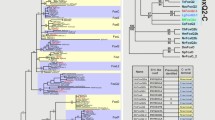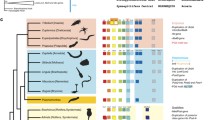Abstract
The Fox genes encode a group of transcription factors that contain a forkhead domain, which forms a structure known as a winged helix. These transcription factors play a crucial role in several key biological processes, including development. High-degree identity in the canonical forkhead domain has been used to divide Fox proteins into 23 families (FoxA to FoxS). We surveyed the genome of three spiralians, the oyster Crassostrea gigas, the limpet Lottia gigantea, and the annelid Capitella teleta. We identified 25 C. gigas fox genes, 21 L. gigantea fox genes, and 25 C. teleta fox genes. The C. gigas fox and L. gigantea fox genes represented 19 of the 23 families, whereas FoxI, Q1, R, and S were missing. The majority of the Fox families were observed within the C. teleta fox genes, with the exception of FoxR and S. In addition, the foxAB-like gene, foxY-like gene, and foxH gene were also present in the three genomes. The conserved FoxC-FoxL1 cluster, observed in mammals, was also found in C. gigas. The diversity of temporal expression patterns observed across the developmental process implies the C. gigas fox genes exert a wide range of functions. Further functional studies are required to gain insight into the evolution of Fox genes in bilaterians.
Similar content being viewed by others
References
Arenas-Mena C. 2006. Embryonic expression of HeFoxA1 and HeFoxA2 in an indirectly developing polychaete. Development Genes and Evolution, 216: 727–736.
Bayne B. 1971. Some Morphological Changes that Occur at the Metamorphosis of the Larvae of Mytilus edulis. Cambridge University Press, Cambridge, Britain. p.259–280.
Bernard F R. 1974. Particle sorting and labial palp function in the Pacific oyster Crassostrea gigas. Biological Bulletin, 146: 1–10.
Berthelin C, Kellner K, Mathieu M. 2000. Histological characterization and glucose incorporation into glycogen of the Pacific oyster Crassostrea gigas storage cells. Marine Biotechnology, 2(2): 136–145.
Boyle M J, Seaver E C. 2008. Developmental expression of foxA and gata genes during gut formation in the polychaete annelid Capitella sp. I. Evolution Development, 10: 89–105.
Boyle M J, Seaver E C. 2010. Expression of FoxA and GATA transcription factors correlates with regionalized gut development in two lophotrochozoan marine worms: Chaetopterus (Annelida) and Themiste lageniformis (Sipuncula). Evolution Development, 1: 2, http://dx.doi.org/10.1186/2041-9139-1-2.
Carlsson P, Mahlapuu M. 2002. Forkhead transcription factors: key players in development and metabolism. Developmental Biology, 250: 1–23.
Clark K L, Halay E D, Lai E, Burley S K. 1993. Co-crystal structure of the HNF-3/fork head DNA-recognition motif resembles histone H5. Nature, 364: 412–420.
Cutting A D, Bannister S C, Doran T J, Sinclair A H, Tizard M V, Smith C A. 2012. The potential role of microRNAs in regulating gonadal sex differentiation in the chicken embryo. Chromosome Research, 20: 201–213.
Fleury E, Huvet A, Lelong C, Lorgeril J, Boulo V, Gueguen Y et al. 2009. Generation and analysis of a 29,745 unique expressed sequence tags from the Pacific oyster ( Crassostrea gigas) assembled into a publicly accessible database: the GigasDatabase. BMC Genomics, 10: 341.
Gosling E M. 2003. Bivalve Molluscs: Biology, Ecology and Culture. Wiley-Blackwell.
Granadino B, Pêrez-Sanchez C, Rey-Campos J. 2000. Fork head transcription factors. Current Genomics, 1: 353–382.
Hiroyuki K, Naoki H, Daichi G S, Hiroki O, Miho Y, Tatsumi S. 2013. A genome-wide survey of genes encoding transcription factors in Japanese pearl oyster Pinctada fucata: II. Tbx, Fox, Ets, HMG, NFκB, bZIP, and C2H2 Zinc Fingers. Zoological Science, 30: 858–867.
Hope I A, Mounsey A, Bauer P, Aslam S. 2003. The forkhead gene family of Caenorhabditis elegans. Gene, 304: 43–55.
Huan P, Wang H X, Dong B, Liu B Z. 2012. Identification of differentially expressed proteins involved in the early larval development of the Pacific oyster Crassostrea gigas. Journal of Proteomics, 75(13): 3 855–3 865.
Huelsenbeck J P, Ronquist F. 2001. MRBAYES: Bayesian inference of phylogenetic trees. Bioinformatics, 17: 754–755.
Kasumi Y, Yutaka S, Françoise M, Shimeld S M, Degnan B. 2003. A genomewide survey of developmentally relevant genes in Ciona intestinalis III. Genes for Fox, ETS, nuclear receptors and NFκB. Development Genes and Evolution, 213: 235–244.
Klaus H K, Walter K, Daniel E M. 2000. Unified nomenclature for the winged helix/forkhead transcription factors. Genes Development, 14: 142–146.
Koba N, Ohfuji T, Ha Y, Mizushima S, Tsukada A, Saito N, Shimada K. 2008. Proflies of mRNA expression of FoxL2, P450arom, DMRT1, AMH, P450c17, SF1, Erα and AR, in relation to gonadal sex differentiation in duck embryo. Journal of Poultry Science, 45: 132–138.
Kos R, Reedy M V, Johnson R L, Erickson C A. 2001. The winged-helix transcription factor FoxD3 is important for establishing the neural crest lineage and repressing melanogenesis in avian embryos. Development, 128: 1 467–1 479.
Lai E, Prezioso V R, Tao W F, Chen W S, Darnell J E. 1991. Hepatocyte nuclear factor 3 alpha belongs to a gene family in mammals that is homologous to the Drosophila homeotic gene fork head. Genes Development, 5: 416–427.
Larroux C, Luke G N, Koopman P, Rokhsar D S, Shimeld S M, Degnan B M. 2008. Genesis and expansion of metazoan transcription factor gene classes. Molecular Biology and Evolution, 25: 980–996.
Lartillot N, Gouar M L, Adoutte A. 2002. Expression patterns of fork head and goosecoid homologues in the mollusc Patella vulgata supports the ancestry of the anterior mesendoderm across Bilateria. Development Genes and Evolution, 212: 551–561.
Li C, Tucker P W. 1993. DNA-binding properties and secondary structural model of the hepatocyte nuclear factor 3/fork head domain. Proceedings of the National Academy of Sciences USA, 90: 11 583–11 587.
Lough R G, Gonor J J. 1971. Early embryonic stages of Adula californiensis (Pelecypoda: Mytilidae) and the effect of temperature and salinity on developmental rate. Marine Biology, 8: 118–125.
Masuko K, Masaru K. 2004. Human FOX gene family. International Journal of Oncology, 25: 1 495–1 500.
Mazet F, Amemiya C T, Shimeld S M. 2006. An ancient Fox gene cluster in bilaterian animals. Current Biology, 16: R314–316.
Mazet F, Luke G N, Shimeld S M. 2005. The amphioxus FOXQ1 gene is expressed in the developing endostyle. Gene Expression Patterns, 5: 313–315.
Mazet F, Shimeld S M. 2002. The evolution of chordate neural segmentation. Development Biology, 251: 258–270.
Mazet F, Yu J K, Liberles D A, Holland L Z, Shimeld S M. 2003. Phylogenetic relationships of the Fox (Forkhead) gene family in the Bilateria. Gene, 316: 79–89.
Michio O, Yutaka S. 2003. Expression of FoxE and FoxQ genes in the endostyle of Ciona intestinalis. Development Genes and Evolution, 213: 416–419.
Monteiro A S, Ferrier D E. 2006. Hox genes are not always colinear. International Journal of Biological Sci ences, 2: 95–103.
Naimi A, Martinez A S, Specq M L, Diss B, Mathieu M, Sourdaine P. 2009. Molecular cloning and gene expression of Cg -FoxL2 during the development and the adult gametogenetic cycle in the oyster Crassostrea gigas. Comparative Biochemistry and Physiology, Part B, 154: 134–142.
Nakae J, Cao Y, Oki M, Orba Y, Sawa H, Kiyonari H, Iskandar K, Suga K, Lombes M, Hayashi Y. 2008. Forkhead transcription factor FoxO1 in adipose tissue regulates energy storage and expenditure. Diabetes, 57(3): 563–576.
Ogg S, Paradis S, Gottlieb S, Patterson G I, Lee L T H A, Ruvkun G. 1997. The Fork head transcription factor DAF-16 transduces insulin-like metabolic and longevity signals in C. elegans. Nature, 389(6654): 994–999.
Pohl B S, Knochel W. 2005. Of fox and frogs: fox(forkhead/winged helix) transcription factors in Xenopus development. Gene, 344: 21–32.
Ransick A, Rast J P, Minokawa T, Calestani C, Davidson E H. 2002. New early zygotic regulators expressed in endomesoderm of sea urchin embryos discovered by differential array hybridization. Development Biology, 246: 132–147.
Ronquist F, Huelsenbeck J P. 2003. MrBayes 3: Bayesian phylogenetic inference under mixed models. Bioinformatics, 19: 1 572–1 574.
Santerre C, Sourdaine P, Martinez A S. 2012. Expression of a natural antisense transcript of Cg-Foxl2 during the gonadic differentiation of the oyster Crassostrea gigas: first demonstration in the gonads of a lophotrochozoa species. Sexual development, 6: 210–221.
Shen X Y, Cui J Z, Gong Q L. 2011. Fox gene loci in Takifugu rubripes and Tetraodon nigroviridis genomes and comparison with those of medaka and zebrafish genomes. Genome, 54: 965–972.
Shen X Y, Cui J Z, Nagahama Y. 2012. The forkhead gene family in medaka: expression patterns and gene evolution. Cytogenet ic and Genome Res earch, 136: 123–130.
Shimeld S M, Boyle M J, Brunet T, Luke G N, Seaver E C. 2010. Clustered Fox genes in lophotrochozoans and the evolution of the bilaterian Fox gene cluster. Developmental Biology, 340: 234–248.
Simakov O, Marletaz F, Cho S J, Edsinger-Gonzales E, Havlak P, Hellsten U. 2012. Insights into bilaterian evolution from three spiralian genomes. Nature, 493: 526–531.
Sridhar H, Klaus H K. 2009. The evolution of Fox genes and their role in development and disease. Nature, 10: 233–240.
Sullivan F X, Kumar R, Kriz R, Stahl M, Xu G Y, Rouse J, Chang X J, Boodhoo A, Potvin B, Cumming D A. 1998. Molecular cloning of human GDP-mannose 4, 6-dehydratase and reconstitution of GDP-fucose biosynthesis in vitro. Journal of Biological Chemistry, 273: 8 193–8 202.
Takahashi H, Takahashi K, Liu F C. 2000. FOXP Genes, Neural Development, Speech and Language Disorders. In: Madame Curie Bioscience Database. Austin (TX): Landes Bioscience. http://www.ncbi.nlm.nih.gov/books/NBK7023/.
Thompson J D, Gibson T J, Plewniak F, Jeanmougin F, Higgins D G. 1997. The CLUSTALX windows interface: flexible strategies for multiple sequence alignment aided by quality analysis tools. Nucleic Acids Research, 25: 4 876–4 882.
Tu Q, Brown C T, Davidson E H, Oliveri P. 2006. Sea urchin Forkhead gene family: phylogeny and embryonic expression. Development Biology, 300: 49–62.
Wang D S, Kobayashi T, Zhou L Y, Paul-Prasanth B, Ijiri S, Sakai F et al. 2007. Foxl2 up-regulates aromatase gene transcription in a female-specific manner by binding to the promoter as well as interacting with ad4 binding protein/steroidogenic factor 1. Molecular Endocrinology, 21: 712–725.
Weigel D, Jäckle H. 1990. The fork head domain: a novel DNA binding motif of eukaryotic transcription factors. Cell, 63: 455–456.
Weigel D, Jurgens G, Kuttner F, Seifert E, Jackle H. 1989. The homeotic gene fork head encodes a nuclear protein and is expressed in the terminal regions of the Drosophila embryo. Cell, 57: 645–658.
Wotton K R, Mazet F, Shimeld S M. 2003. Expression of FoxC, FoxF, FoxL1, and FoxQ1 genes in the dogfish Scyliorhinus canicula defines ancient and derived roles for Fox genes in vertebrate development. Developmental Dynamics, 237: 1 590–1 603.
Yu J K, Mazet F, Chen Y T, Huang S W, Jung K C, Shimeld S M. 2008. The Fox genes of Branchiostoma floridae. Development Genes and Evolution, 218: 629–638.
Zannini M, Avantaggiato V, Biffali E, Aronone M I, Sato K, Pischetola M, Taylor B A, Phillips S J, Simeone A, Di Lauro R. 1997. TTF-2, a new forkhead protein, shows a temporal expression in the developing thyroid which is consistent with a role in controlling the onset of differentiation. EMBO Journal, 16(11): 3 185–3 197.
Zhang G F, Fang X D, Guo X M, Li L, Luo R B, Xu F et al. 2012. The oyster genome reveals stress adaptation and complexity of shell formation. Nature, 490: 49–54.
Author information
Authors and Affiliations
Corresponding authors
Additional information
Supported by the National Basic Research Program of China (973 Program) (No. 2010CB126401), the National Natural Science Foundation of China (No. 31402285), the National High Technology Research and Development Program of China (863 Program) (No. 2012AA10A405), the Earmarked Fund for Modern Agro-Industry Technology Research System (No. CARS-48), the Taishan Scholars Climbing Program of Shandong Province, and the Oversea Taishan Scholars Program of Shandong Province
Rights and permissions
About this article
Cite this article
Yang, M., Xu, F., Liu, J. et al. Phylogeny of forkhead genes in three spiralians and their expression in Pacific oyster Crassostrea gigas . Chin. J. Ocean. Limnol. 32, 1207–1223 (2014). https://doi.org/10.1007/s00343-015-4009-x
Received:
Accepted:
Published:
Issue Date:
DOI: https://doi.org/10.1007/s00343-015-4009-x




